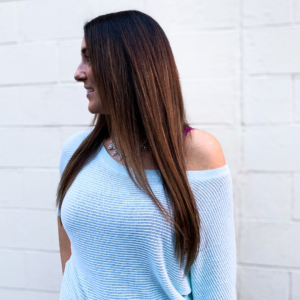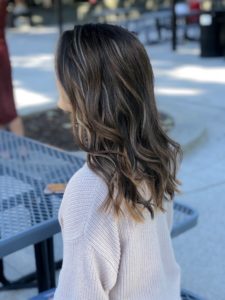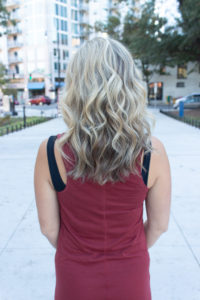How To Tell If Your Hair Is In Good Condition
The condition of your hair isn’t exactly considered a hair type, but it plays a huge role in how to care for it and what products you should be using. In this post we’ll help you to determine what condition your hair is in, as well as what you can do to improve it.
Is my hair in good condition?
Below we’ll break your hairs’ condition down into three categories:
- Healthy and virgin hair
- Slight damage and color treated hair
- Damaged and bleached hair

***Since I’m sharing the products that I love to use with you guys, this page includes affiliate links to these products. If you take action and purchase a product through clicking one of my links, I’ll make some commission money from it at no extra cost to you. This enables me to be able to continue giving you awesome hair tips, so thanks! ***
1. How to know if your hair is healthy
Healthy and virgin hair is in its best condition possible. Keep in mind that you can have virgin hair without it necessarily being healthy, and you can also have healthy hair without it being virgin. And if you don’t know, virgin hair means that it has never been chemically treated. So no color, perms, or relaxers unless it’s completely grown out and been cut off.
This category is for virgin AND healthy hair without any damage. If you have virgin hair but it has some split ends or fly-aways traveling up your hair strand, then skip to the next section on slightly damaged and color treated hair.
One benefit about healthy hair is that you can skip some of the steps that most of us have to go through to maintain our luscious locks. But you still need to make sure that you’re taking proper care of it so that it stays this way and doesn’t become damaged.
Key takeaways: Virgin hair; no split ends or flyaways traveling up the hair strand
How to care for healthy and virgin hair
- Keep up with regular haircuts and trims. Check out my post here to find out how often you should be getting your hair cut based on your hair type.
- Use professional grade products over drugstore or Sallys brands. Here I list my favorite professional lines.
- Always use a thermal protectant before you blow dry and a separate one before you iron. Yes that means 2 heat protectants!
- Be careful with tight elastic hair ties, headbands, and rough brushing. Anything that puts tension on the hair can cause breakage and split ends.
- Use a masque or conditioning treatment at least once a month.
Best hairstyles for healthy hair
Healthy haired gals are lucky because there aren’t many limitations. One main problem that you may face with this hair condition is having a hard time achieving volume and/or body.
Because the hair is so smooth and moisturized, it just wants to lay flat. I recommend using volumizing products or adding more layers and texture if you experience this problem.
Most of the products that I recommend for healthy hair are volumizing. But this doesn’t mean that you shouldn’t be using products to prevent damage and keep the hair moisturized.
Best hair products for healthy hair
- Aquage Uplifting Foam – Mousse and root-lifter. Use half a golf-ball sized fluff, apply to your root area and style.
- Aquage Freezing spray – This is a strong hold hairspray that provides maximum humidity resistance. This works well for strong hair types such as course, thick, or stick straight hair when you want it to hold a curl.
- Kenra – Blow-Out Spray — This is a blow-out spray that adds volume, body, shine, and provides protection against heat tools. It’s super light-weight and doesn’t leave the hair feeling gunky. Spray all over and blow-out.
- Amika Perk Up Dry Shampoo – The best dry shampoo on the market. Doesn’t leave a residue, absorbs oils, and smells great. Spray at your root area, rub in with your fingers, and style.
- Amika The Shield– This is a heat-activated spray that protects your hair from heat tools and humidity.
- Amika Un.Done Texture Spray– This is my favorite texture spray. It adds volume and texture to give you the ultimate “un-done” look.
- Kenra Volume Shampoo and Conditioner – Volumizing shampoo and conditioner that won’t weigh hair down. I love this for fine hair, but it can also be used on heavy or coarse hair that has a tendency to get weighed down.
2. Slightly damaged and color treated hair

If you have color on your hair (not highlights or bleach) or if you use an iron frequently, then this section is for you. A little bit of damage is expected when coloring and ironing your hair frequently.
If you have significant flyaways, your hair has lost its wave pattern, or the bottom several inches of your hair is straggly and frizzy, skip to the next section on damaged and bleached hair.
This middle category isn’t the worst, but there are definitely extra steps you need to be taking to make your hair in healthier condition. What’s most important is that you are taking the proper measures to repair any damage as well as avoid making the condition any worse.
Key takeaways: Color treated but not bleached; frequently ironed virgin hair; split ends at the bottom, not traveling up the hair strand.
How to care for slightly damaged and color treated hair
- Use a sulfate free, color protect shampoo and conditioner. Even if you don’t have color on your hair, a sulfate free shampoo is not as harsh and won’t dry your hair out.
- Use cool water. Heat and steam opens up the cuticle of your hair (the outer layer that resembles fish scales), which will pull out your hair color and make it appear more frizzy.
- Keep up with regular haircuts and trims. On this post I explain how often you should be getting a trim to maintain the condition of your hair.
- Use professional grade products over drugstore or Sallys brands. Here I list my favorite lines.
- Always use a thermal protectant before you blow dry and a separate one before you iron.
- Be careful with tight hair ties, headbands, towels, and brushing. Anything that puts significant tension on the hair can cause breakage.
- Use a masque or conditioning treatment every 1-2 weeks.
Best hairstyles for slightly damaged and color treated hair
The main consideration for hair that is slightly damaged is that you aren’t putting it through anything that will make the condition worse.
I would avoid ironing it frequently, or anything that will put significant pressure and tension on your hair.
Loose braids are great because they hold your hair back without keeping tension on one spot like a pony tail will. The rubber band is at the ends of the hair without much pressure. When your hair is in a high pony, the weight of your hair is pulling against that rubber band.
Always use a sulfate free shampoo and conditioner to avoid drying out your hair and fading the color. If your hair is color treated, you NEED to be using a masque every 2 weeks; possibly more if your hair is dry. These hair treatments strengthen and chemically repair the broken bonds in your hair. They are way better than using coconut oil, trust me!
Best hair products for slightly damaged and color treated hair
- Aquage Silkening Shampoo and Conditioner – Perfect for fragile or color treated hair. This shampoo and conditioner helps to smooth down the hair, reduce frizz, and my favorite aspect, protect against humidity.
- Aquage Silkening Oil Treatment – Hair serum. It’s used for blow-drying, anti-frizz, anti-humidity, and heat protection. It even cuts your blow-dry time down! Apply 1 pump evenly and blow it out or let it air dry.
- Aquage Beyond Shine – A thermal heat protectant and humidity resistant spray that increases shine and increases iron performance. Spray generously before ironing.
- Pravana Intense Therapy leave-in – This is a light weight detangler, leave-in conditioner, UV and heat protectant, and is also humidity resistant. Spray a couple squirts when hair is damp, comb through and style.
- Pravana Intense Therapy Treat Masque – Use this masque once a week to maintain moisture and repair broken bonds.
3. Damaged and bleached hair

When your hair is damaged whether it’s from over-processing, heat damage, or simply negligence; using professional grade hair products is a MUST to maintain the condition of your hair.
When your hair is damaged you’ll have flyaways traveling up your hair strand from the bottom. The split ends are impossible to cut off because your entire hair is a split end, literally.
The hair may lose its wave pattern when it’s become damaged. Curls will go straight when the hair is in bad condition.
Your hair will also struggle to hold onto moisture and color. This is because the outer layer of your hair is damaged, which leaves the middle layer wide open. When this happens, theres nothing to keep the color or moisture present.
Check out my post here for extra tips on how to maintain long and healthy hair.
Key takeaways: Highlighted or bleached; damage and flyaways traveling up the hair strand; loss of wave pattern; doesn’t hold onto hair color
How to care for damaged and bleached hair
- Use a shampoo and conditioner that not only protects the color but also aids in the recovery of the hair structure.
- If you aren’t putting anything into your hair when you get out of the shower, then you’re doing it all wrong. I recommend a leave-in conditioner AND a hair serum.
- You should be using a masque every time you wash your hair. I recommend alternating between a bond builder and a moisturizing masque.
- Do NOT wrap your hair into a turban on your head with a large bath towel! You can use a small towel if you know how, but a large towel will cause breakage around your hairline from the pressure and weight of the wet towel. They make specific towels for this like this one!
- Be very careful when brushing wet hair, it can break right off if you brush too vigorously.
- I suggest avoiding putting your hair up in a high pony or messy bun at all costs. Yes I said it. Hair ties and clips can cause significant breakage on already damaged and over-processed hair. Keep it down or in a loose braid. And if you must, a low pony instead of a high bun.
- Cover your hair from the sun with a hat or UV protectant so your hair doesn’t get sun burned. More on sun damage here.
- Avoid using heat at all costs. This means only blow dry and iron when absolutely necessary. If you must do one, blow dry instead of iron. The indirect heat is safer than the heat of an iron.
- Shampoo your hair as infrequently as possible. Shampoo dries out the hair by removing natural oils as well as fades the color. Check out my post here to learn how often you should be washing your hair.
Best hairstyles for damaged and bleached hair
To improve the condition of your damaged or bleached hair, you probably are not going to be happy with me after reading this section, but as Lizzo says, the truth hurts!
If your hair is damaged, you should try to wear it down and natural as much as possible. Putting your hair up with hair ties and headbands can cause significant damage on already fragile hair. Avoid anything that puts tension on your hair, ESPECIALLY messy buns.
You should also only blow-dry or iron when absolutely necessary. Even when using thermal protecting products, no heat is still much much better. As I mentioned earlier, if you must do one, choose blow drying. It is much less damaging than ironing is. And always use a thermal protectant before you blow dry or iron!
Best hair products for damaged hair
- Olaplex No. 3 – Bond builder. Use this on wet hair BEFORE you shampoo and condition. Leave it in for a MINIMUM of 10 minutes, then shampoo it out. I recommend alternating this with the pravana masque listed below.
- Olaplex No.4 – No.5 – Bond building shampoo and conditioner. Can be used regularly especially if you have chemically damaged hair.
- Olaplex No. 6 – Leave-in conditioner and styling treatment. This repairing leave-in conditioner hydrates, eliminates frizz, and protects the hair from heat. Use after you shampoo and condition.
- Pravana Intense Therapy Shampoo, Conditioner, and Masque – This is a great combo for color treated and over-processed hair. They moisturize the hair as well as restore the elasticity. I recommend alternating this masque with Olaplex no.3 each wash.
- Pravana Intense Therapy leave-in – Light weight detangler, leave-in conditioner, UV and heat protectant, and is also humidity resistant. Spray in when hair is damp, comb through and style.
- Aquage Silkening Shampoo and Conditioner – Shampoo and conditioner that helps to smooth, reduce frizz, and protect against humidity.
- Aquage Silkening Oil Treatment – Hair serum used for blow-drying, anti-frizz, anti-humidity, and heat protection. It even cuts your blow-dry time down! Apply 1 pump evenly and blow it out or let it air dry.
- Aquage Beyond Shine – Thermal heat protectant and humidity resistant spray that increases shine and iron performance. Spray generously before ironing.
Condition of the hair conclusion
The condition in your hair plays a role in how you can color it, what styles you should be wearing, how you care for it, and what products you choose to use.
Healthy and Virgin hair
- Not color treated
- No split ends traveling up the hair
- May lack volume
- Use volume & moisture products
Slight Damage and Color Treated hair
- May be color treated
- Split ends
- Ironed frequently
- May lack moisture
- Use color safe & moisture products
Damaged and Bleached hair
- Highlighted or bleached
- Damage & flyaways traveling up hair strand
- Loss of wave pattern
- Lacks moisture
- Use strengthening & moisturizing products
- Avoid heat tools
- Avoid tension on the hair
If you have any further questions for me on this topic, leave them for me in the comments! As always, Have A Good Hair Day!
Last Updated 12/03/2023



Comments